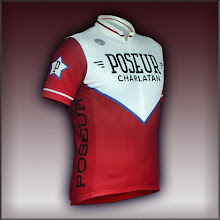In a footnote in this essay, I said that I thought it could be argued that a cyclist in Texas only had the rights as driver of any other type of vehicle when he was operating on the roadway, and these rights [1] did not extend to operations on the shoulders.
I made those statements hastily, and I have spent some time considering it anew, and I was wrong.
Sec. 551.001. PERSONS AFFECTED. This chapter applies only to a person operating a bicycle on:
(1) a highway; or
(2) a path set aside for the exclusive operation of bicycles.
All well and good, but what does "highway" mean?
Sec. 541.302. (5) "Highway or street" means the width between the boundary lines of a publicly maintained way any part of which is open to the public for vehicular travel.
I am now convinced, after ruminating on it for some time, it means in a more plain way this: "Public maintained property with a roadway, from fence line to fence line".
This definition is structured this way to exclude publicly maintained property such as a high voltage power line’s right of way or parks and recreation areas.
I therefore retract my public speculation that our road rights end at the edge of the travel lane.
[1] Sec. 551.101. RIGHTS AND DUTIES. (a) A person operating a bicycle has the rights and duties applicable to a driver operating a vehicle under this subtitle, unless:
(1) a provision of this chapter alters a right or duty; or
(2) a right or duty applicable to a driver operating a vehicle cannot by its nature apply to a person operating a bicycle.
RANTWICK LOVES the USA
9 months ago



Chip, Chip, Chip,
ReplyDeleteAs in most things cycling, John Forester discusses this in EFFECTIVE CYCLING. Specifically, on page 292, he notes "The FHWA's position is that cyclists are legitimate users of dirt, ditches, sidewalks, and bike paths (the other parts of a highway), but not of roadways."
Almost forgot, be sure to wish the ChipSeal multitudes a Merry Christmas!
ReplyDelete545.058. DRIVING ON IMPROVED SHOULDER.
ReplyDelete(a) An operator may drive on an improved shoulder to the right of the main traveled portion of a roadway if that operation is necessary and may be done safely, but only:
...
(c) A limitation in this section on driving on an improved shoulder does not apply to:
(1) an authorized emergency vehicle responding to a
call;
(2) a police patrol; or
(3) a bicycle.
...
Based on that, I come to the same conclusion you do -- that the shoulder is considered part of the roadway.
Doug, the shoulder is not part of the "roadway", but it is part of the "highway".
ReplyDeleteThe TTC defines roadway as the main traveled part of the highway, excluding the berm or shoulder.
545.058 is then using a different definition of "roadway", for "to the right of the main traveled portion of a roadway" implies "roadway" is more than "the main traveled portion of a roadway". That is, there is "the main traveled portion of a roadway", and there is "the secondarily traveled part of the roadway".
ReplyDeleteLet's just say the vehicle code is not an engineering document.